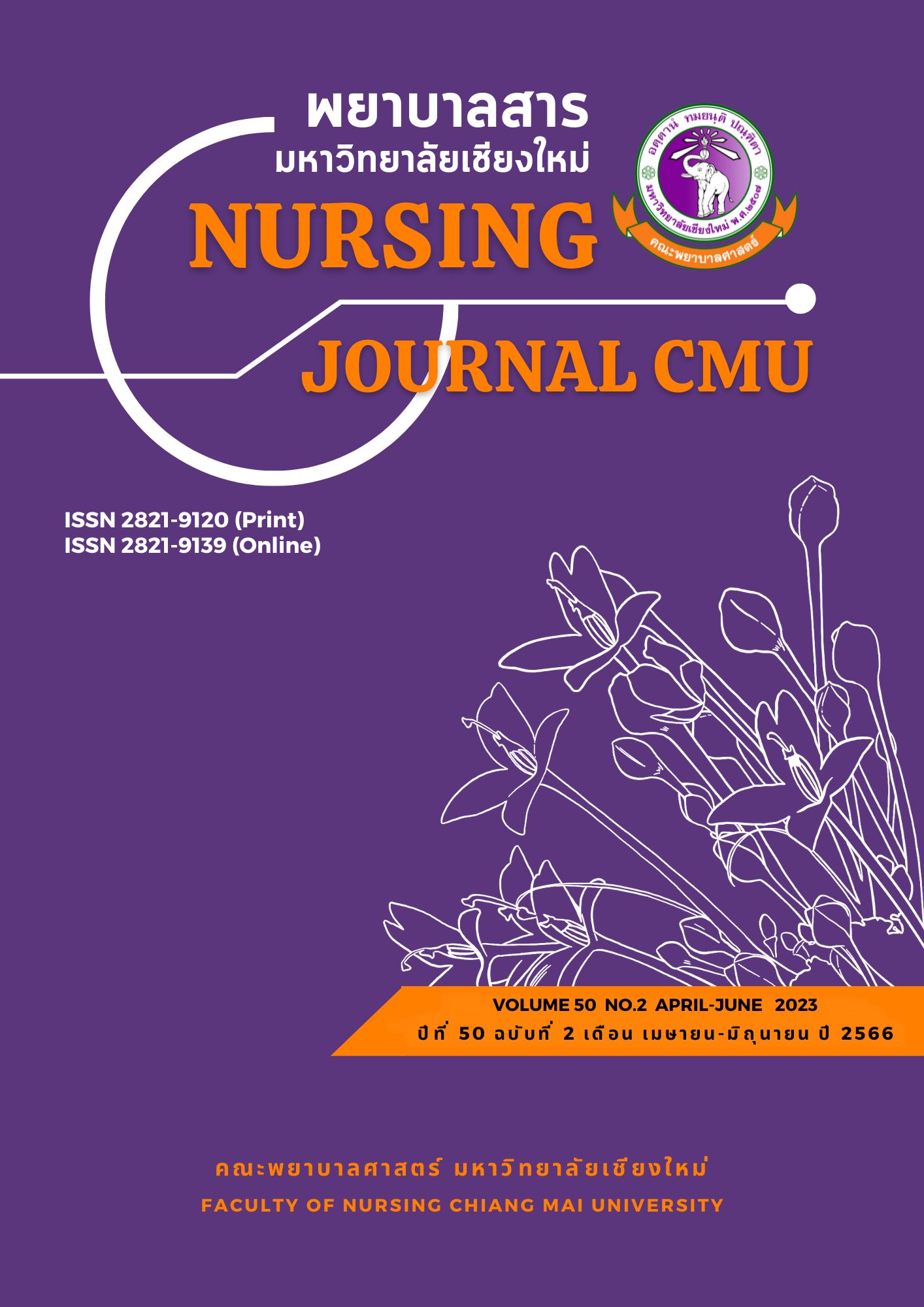Effort–Reward Imbalance and Job Burnout of Nurses in Tertiary Hospitals
Keywords:
Effort- reward imbalance, Job burnout, Emotional exhaustion, Depersonalization, Personal accomplishment, Tertiary hospitalAbstract
Effort-reward imbalance results in stress, and if a worker's effort is not balanced with rewards, this can result in job burnout. The purposes of this study were to explore nurses’ effort-reward imbalance and job burnout, and the relationship between effort-reward imbalance and job burnout. The study sample was comprised of 367 nurses working in tertiary hospitals in the northeast region, selected using multi-stage random sampling. The research instrument was a questionnaire consisting of three parts: 1) a demographic data form; 2) the Effort-Reward Imbalance Questionnaire (ERIQ); and 3) the Maslach Burnout Inventory (MBI) which consists of 3 subscales: emotional exhaustion, depersonalization, and reduced personal accomplishment. The reliability coefficient of the ERIQ was 0.89, and the reliabilities for the subscales of the MBI were 0.93, 0.88, and 0.80, respectively. Data were analyzed using descriptive statistics and Spearman’s rank-order correlation.
The study results were as follows:
1. The majority of nurses perceived more effort than reward (= 1.02, SD = .22) and had over-commitment ( = 19.32, SD = 3.759).
2. The majority of nurses had emotional exhaustion at a high level (= 31, SD = 7.627) while having depersonalization and reduced personal accomplishment at low levels (= 3.91, SD = 5.164; = 18.72, SD = 9.301, respectively).
3. Effort–reward imbalance was positively correlated with two subscales of job burnout, emotional exhaustion and depersonalization (rs = .241, p < .01 and rs = .273, p < .01, respectively), but effort-reward imbalance was not correlated with reduced personal accomplishment.
These findings could be used as fundamental information for nursing administrators and hospital administrators to consider balancing work rewards with the efforts of nurses which would lead to further reductions in job burnout among nurses.
References
Adams, J. S. (1965). Inequity in social exchange. In L. Berkowitz (Ed.), Advances in Experimental Social Psychology, 2 (pp. 267-299). Cambridge: Academic Press. doi: 10.1016/S0065-2601(08)60108-2
Aiken, L. H., Clarke, S. P., Sloane, D. M., Sochalski, J., & Silber, J. H. (2002). Hospital nurse staffing and patient mortality, nurse burnout, and job dissatisfaction. JAMA, 288(16), 1987-1993. doi: 10.1001/jama.288.16.1987
Bakker, A. B., Killmer, C. H., Siegrist, J., & Schaufeli, W. B. (2000). Effort–reward imbalance and burnout among nurses. Journal of Advanced Nursing, 31(4), 884-891. doi: 10.1046/j.1365-2648.2000.01361.x
Buapetch, A. (2007). Development of the instrument for measuring psychosocial work environment in Thai garment workers (Doctoral dissertation). Mahidol University, Thailand.
Fortunatti, P. C., & Palmeiro-Silva, Y. K. (2017). Effort-reward imbalance and burnout among ICU nursing staff: A cross-sectional study. Nursing Research, 66(5), 410-416. doi: 10.1097/nnr.0000000000000239
Jintarat, B., & Sithisarankul, P. (2022). Emotional labor and burnout in nursing profession. Journal of Preventive Medicine Association of Thailand, 11(2), 435-446. Retrieved from https://he01.tcithaijo.org/index.php/JPMAT/article/download/ 248421/170135/937491 (in Thai)
Kakandee, N., Cheevakasemsook, A., & Triwijitkun, D. (2020). Job burnout of generation Y professional nurses at a government hospital. Journal of The Royal Thai Army Nurses, 21(1), 293 – 301. Retrieved from https://he01.tci-thaijo.org/index.php/ JRTAN/article/ download/241573/164288/ (in Thai)
Lubbadeh, T. (2020). Job burnout: A general literature review. International Review of Management and Marketing, 10(3), 7-15. doi: 10.32479/irmm.9398
Maslach, C., & Jackson, S. E. (1981). The measurement of experienced burnout. Journal of Organizational Behavior, 2(2), 99-113. doi: 10.1002/job.4030020205
Maslach, C., Schaufeli, W. B., & Leiter, M. P. (2001). Job burnout. Annual Review of Psychology, 52(1), 397-422. doi: 10.1146/annurev.psych.52.1.39
Ministry of Public Health. (2021). Criteria for risk reimbursement of staff working in surveillance, investigation, prevention, control and treatment of patients infected with Coronavirus 2019. Retrieved from https://hp.anamai.moph.go.th/th/manual-of official/download?id=86033&mid= 35018&mkey=m_document&lang=th&did=27817
Nantsupawat, A., Nantsupawat, R., Kunaviktikul, W., Turale, S., & Poghosyan, L. (2016). Nurse burnout, nurse-reported quality of care, and patient outcomes in Thai hospitals. Journal of Nursing Scholarship, 48(1), 83-90. doi: 10.1111/jnu.12187
Sawangdee, K. (2017). Crisis of nursing shortage in health service facilities under Office of Permanent Secretary, Ministry of Public Health: Policy recommendations. Journal of Health Science, 26(2), 456-468. (in Thai)
Sawangdee, K., Chaichuen, W., & Decha, N. (2019). Manpower reform plan and health service mission. Nonthaburi: Ministry of Public Health. Retrieved from https://pt.or.th/PTCouncil/file_attach/Att201907301564486064_ 1.pdf (in Thai)
Siegrist, J. (1996). Adverse health effects of high-effort/low-reward conditions. Journal of Occupational Health Psychology, 1(1), 27-41. doi: 10.1037//1076-8998.1.1.27
Summawart, S. (1989). Burnout among the staff nurses in Ramathibodi Hospital (Master’s thesis). Mahidol University, Thailand. (in Thai)
Swatdiwong, P., & Bormann, V. S. (2019). Relationship between Head Nurse’s supervision style and registered nurse’s care for patient safety in tertiary hospitals. Nursing Journal, 46(4), 158-172. Retrieved from https://he02.tci-thaijo.org/index.php/ cmunursing/article/view/230364/156794 (in Thai)
Thamrongvisava, S., Pitanupong, J., & Srisintorn, W. (2019). Burnout and associated factors among nurses at Songklanagarind Hospital. Royal Thai Army Medical Journal, 72(3), 177-185. Retrieved from https://he02.tci-thaijo.org/index.php/rtamedj/article/ view/218984/151905 (in Thai)
Tianjaruwattana, W., & Nawsuwan, K. (2021). Development of the public health workforce of the office of the permanent secretary, Ministry of Public Health to support health region. Journal of Health Science, 30(3), 531-546. (in Thai)
Yamane, T. (1973). Statistics: An introductory analysis. New York: Harper & Row.
Yaowapak, J., & Surinya, T. (2022) Attitude towards nursing profession, self esteem and happiness at work among professional nurses at Paolo Hospital, Phaholyothin Phaya Thai, in Bangkok. Suan Dusit Graduate School Academic Journal Suan Dusit University, 18(3), 1-17. Retrieved from http://www.graduate.dusit.ac.th/journal/index.php/sdujournal/article/view/1101 (in Thai)
Yuan, Z., Yu, D., Zhao, H., Wang, Y., Jiang, W., Chen, D., … Li, X. (2021). Burnout of healthcare workers based on the effort-reward imbalance model: A cross-sectional study in China. International Journal of Public Health, 66(9). doi: 10.3389/ijph.2021.599831
Downloads
Published
How to Cite
Issue
Section
License
Copyright (c) 2023 Nursing Journal

This work is licensed under a Creative Commons Attribution-NonCommercial-NoDerivatives 4.0 International License.
บทความที่ได้รับการตีพิมพ์เป็นลิขสิทธิ์ของวารสารพยาบาลสาร
ข้อความที่ปรากฏในบทความแต่ละเรื่องในวารสารวิชาการเล่มนี้เป็นความคิดเห็นส่วนตัวของผู้เขียนแต่ละท่านไม่เกี่ยวข้องกับมหาวิทยาลัยเชียงใหม่ และคณาจารย์ท่านอื่นๆในมหาวิทยาลัยฯ แต่อย่างใด ความรับผิดชอบองค์ประกอบทั้งหมดของบทความแต่ละเรื่องเป็นของผู้เขียนแต่ละท่าน หากมีความผิดพลาดใด ๆ ผู้เขียนแต่ละท่านจะรับผิดชอบบทความของตนเองแต่ผู้เดียว






